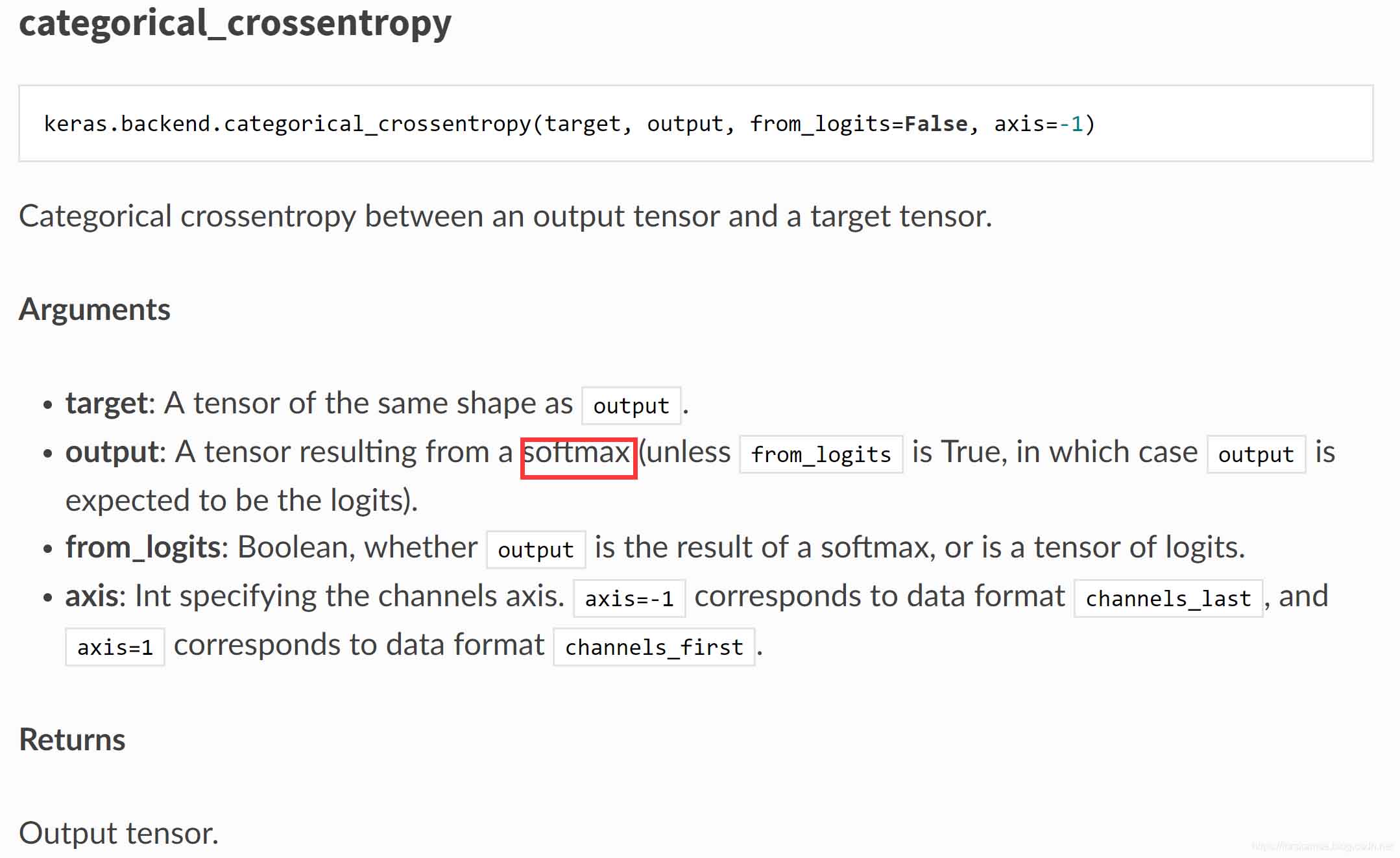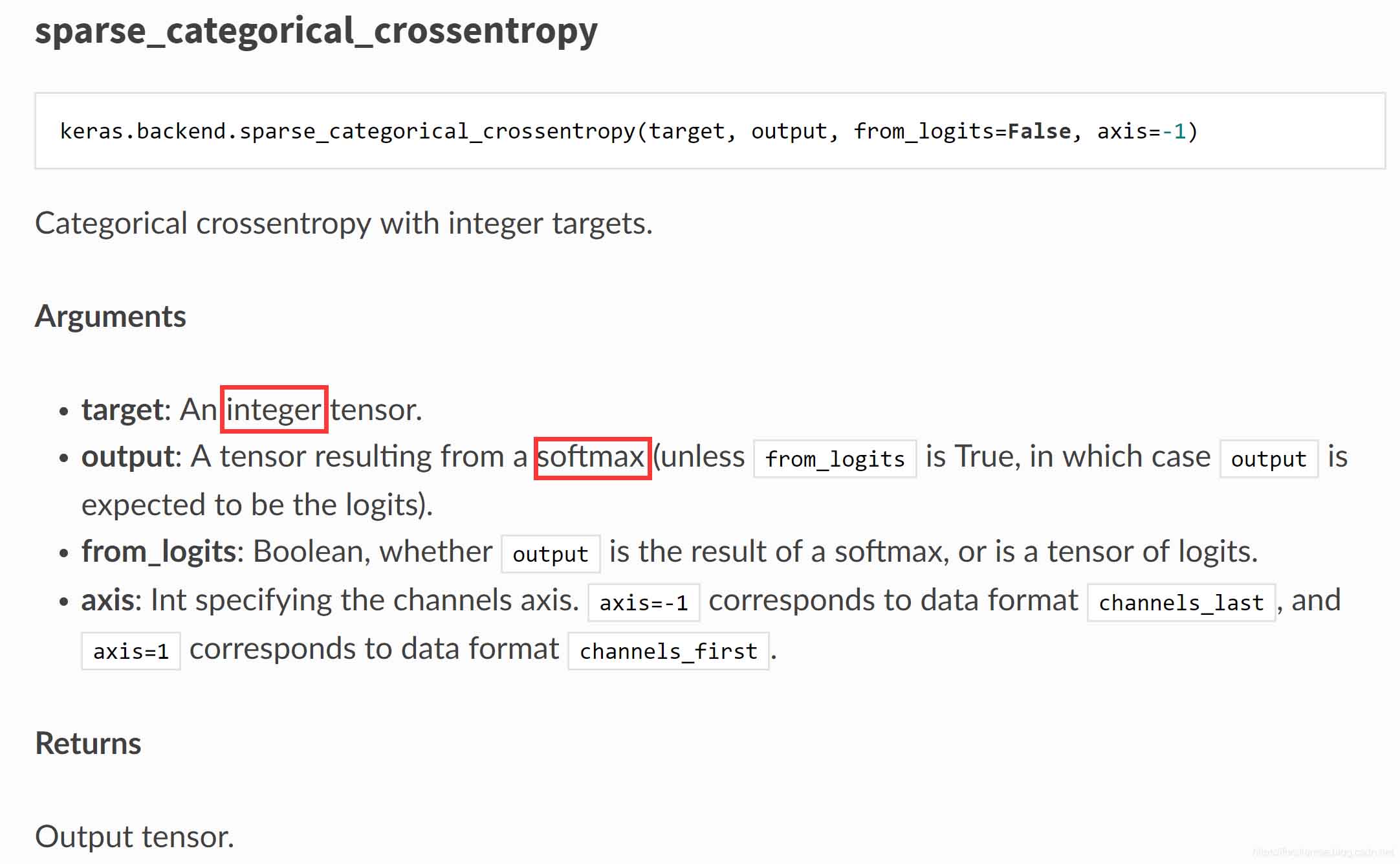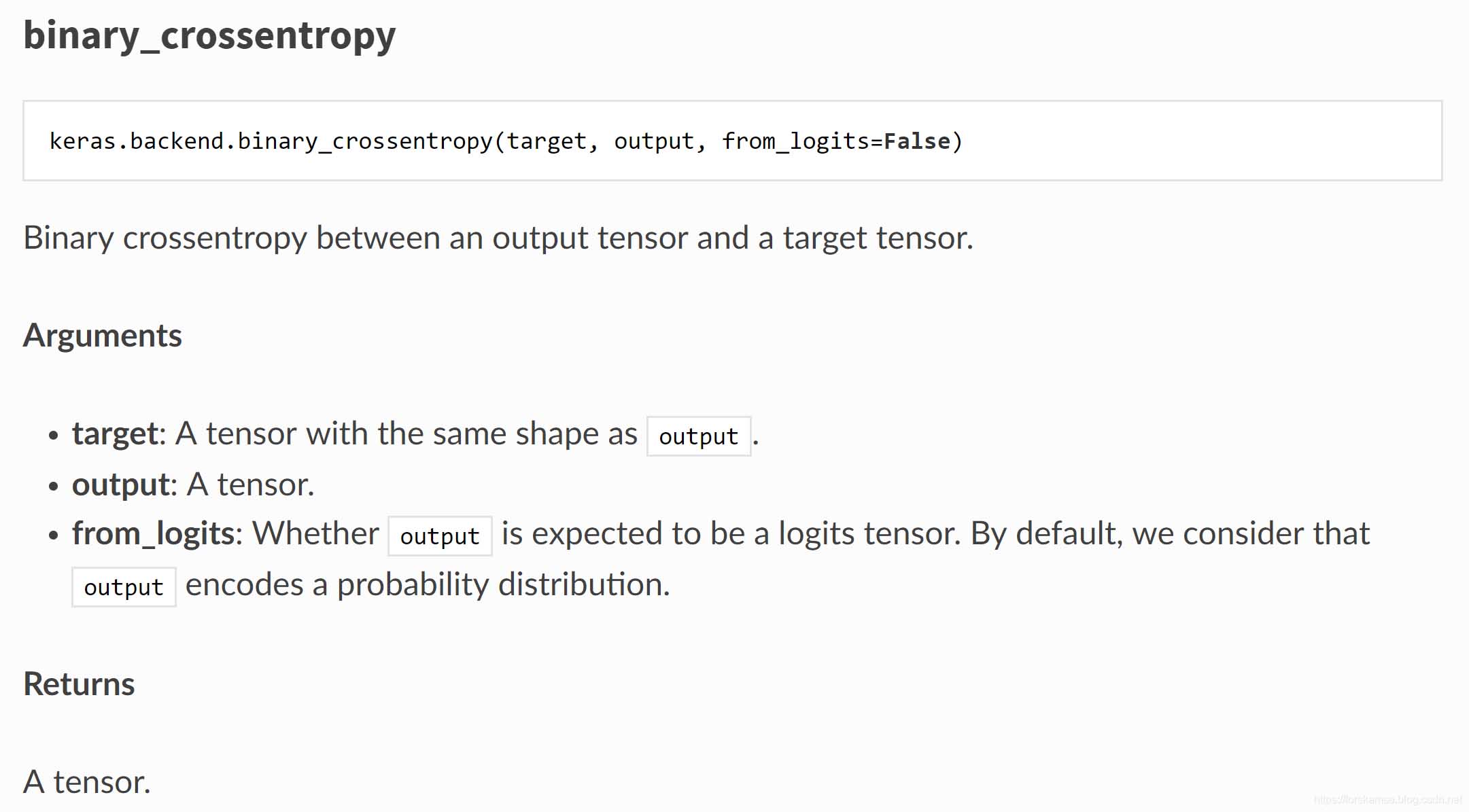本文研究Keras自帶的幾個常用的Loss Function。
1. categorical_crossentropy VS. sparse_categorical_crossentropy


注意到二者的主要差別在于輸入是否為integer tensor���。在文檔中�,我們還可以找到關于二者如何選擇的描述:

解釋一下這里的Integer target 與 Categorical target��,實際上Integer target經過獨熱編碼就變成了Categorical target�����,舉例說明:
(類別數(shù)5)
Integer target: [1,2,4]
Categorical target: [[0. 1. 0. 0. 0.]
[0. 0. 1. 0. 0.]
[0. 0. 0. 0. 1.]]
在Keras中提供了to_categorical方法來實現(xiàn)二者的轉化:
from keras.utils import to_categorical
categorical_labels = to_categorical(int_labels, num_classes=None)
注意categorical_crossentropy和sparse_categorical_crossentropy的輸入參數(shù)output,都是softmax輸出的tensor��。我們都知道softmax的輸出服從多項分布�,
因此categorical_crossentropy和sparse_categorical_crossentropy應當應用于多分類問題�����。
我們再看看這兩個的源碼���,來驗證一下:
https://github.com/tensorflow/tensorflow/blob/r1.13/tensorflow/python/keras/backend.py
--------------------------------------------------------------------------------------------------------------------
def categorical_crossentropy(target, output, from_logits=False, axis=-1):
"""Categorical crossentropy between an output tensor and a target tensor.
Arguments:
target: A tensor of the same shape as `output`.
output: A tensor resulting from a softmax
(unless `from_logits` is True, in which
case `output` is expected to be the logits).
from_logits: Boolean, whether `output` is the
result of a softmax, or is a tensor of logits.
axis: Int specifying the channels axis. `axis=-1` corresponds to data
format `channels_last', and `axis=1` corresponds to data format
`channels_first`.
Returns:
Output tensor.
Raises:
ValueError: if `axis` is neither -1 nor one of the axes of `output`.
"""
rank = len(output.shape)
axis = axis % rank
# Note: nn.softmax_cross_entropy_with_logits_v2
# expects logits, Keras expects probabilities.
if not from_logits:
# scale preds so that the class probas of each sample sum to 1
output = output / math_ops.reduce_sum(output, axis, True)
# manual computation of crossentropy
epsilon_ = _to_tensor(epsilon(), output.dtype.base_dtype)
output = clip_ops.clip_by_value(output, epsilon_, 1. - epsilon_)
return -math_ops.reduce_sum(target * math_ops.log(output), axis)
else:
return nn.softmax_cross_entropy_with_logits_v2(labels=target, logits=output)
--------------------------------------------------------------------------------------------------------------------
def sparse_categorical_crossentropy(target, output, from_logits=False, axis=-1):
"""Categorical crossentropy with integer targets.
Arguments:
target: An integer tensor.
output: A tensor resulting from a softmax
(unless `from_logits` is True, in which
case `output` is expected to be the logits).
from_logits: Boolean, whether `output` is the
result of a softmax, or is a tensor of logits.
axis: Int specifying the channels axis. `axis=-1` corresponds to data
format `channels_last', and `axis=1` corresponds to data format
`channels_first`.
Returns:
Output tensor.
Raises:
ValueError: if `axis` is neither -1 nor one of the axes of `output`.
"""
rank = len(output.shape)
axis = axis % rank
if axis != rank - 1:
permutation = list(range(axis)) + list(range(axis + 1, rank)) + [axis]
output = array_ops.transpose(output, perm=permutation)
# Note: nn.sparse_softmax_cross_entropy_with_logits
# expects logits, Keras expects probabilities.
if not from_logits:
epsilon_ = _to_tensor(epsilon(), output.dtype.base_dtype)
output = clip_ops.clip_by_value(output, epsilon_, 1 - epsilon_)
output = math_ops.log(output)
output_shape = output.shape
targets = cast(flatten(target), 'int64')
logits = array_ops.reshape(output, [-1, int(output_shape[-1])])
res = nn.sparse_softmax_cross_entropy_with_logits(
labels=targets, logits=logits)
if len(output_shape) >= 3:
# If our output includes timesteps or spatial dimensions we need to reshape
return array_ops.reshape(res, array_ops.shape(output)[:-1])
else:
return res
categorical_crossentropy計算交叉熵時使用的是nn.softmax_cross_entropy_with_logits_v2( labels=targets, logits=logits),而sparse_categorical_crossentropy使用的是nn.sparse_softmax_cross_entropy_with_logits( labels=targets, logits=logits)���,二者本質并無區(qū)別�����,只是對輸入參數(shù)logits的要求不同��,v2要求的是logits與labels格式相同(即元素也是獨熱的),而sparse則要求logits的元素是個數(shù)值�����,與上面Integer format和Categorical format的對比含義類似���。
綜上所述��,categorical_crossentropy和sparse_categorical_crossentropy只不過是輸入參數(shù)target類型上的區(qū)別,其loss的計算在本質上沒有區(qū)別���,就是交叉熵���;二者是針對多分類(Multi-class)任務的。
2. Binary_crossentropy

二元交叉熵�,從名字中我們可以看出�����,這個loss function可能是適用于二分類的����。文檔中并沒有詳細說明,那么直接看看源碼吧:
https://github.com/tensorflow/tensorflow/blob/r1.13/tensorflow/python/keras/backend.py
--------------------------------------------------------------------------------------------------------------------
def binary_crossentropy(target, output, from_logits=False):
"""Binary crossentropy between an output tensor and a target tensor.
Arguments:
target: A tensor with the same shape as `output`.
output: A tensor.
from_logits: Whether `output` is expected to be a logits tensor.
By default, we consider that `output`
encodes a probability distribution.
Returns:
A tensor.
"""
# Note: nn.sigmoid_cross_entropy_with_logits
# expects logits, Keras expects probabilities.
if not from_logits:
# transform back to logits
epsilon_ = _to_tensor(epsilon(), output.dtype.base_dtype)
output = clip_ops.clip_by_value(output, epsilon_, 1 - epsilon_)
output = math_ops.log(output / (1 - output))
return nn.sigmoid_cross_entropy_with_logits(labels=target, logits=output)
可以看到源碼中計算使用了nn.sigmoid_cross_entropy_with_logits�,熟悉tensorflow的應該比較熟悉這個損失函數(shù)了�����,它可以用于簡單的二分類����,也可以用于多標簽任務��,而且應用廣泛��,在樣本合理的情況下(如不存在類別不均衡等問題)的情況下���,通??梢灾苯邮褂?。
補充:keras自定義loss function的簡單方法
首先看一下Keras中我們常用到的目標函數(shù)(如mse,mae等)是如何定義的
from keras import backend as K
def mean_squared_error(y_true, y_pred):
return K.mean(K.square(y_pred - y_true), axis=-1)
def mean_absolute_error(y_true, y_pred):
return K.mean(K.abs(y_pred - y_true), axis=-1)
def mean_absolute_percentage_error(y_true, y_pred):
diff = K.abs((y_true - y_pred) / K.clip(K.abs(y_true), K.epsilon(), np.inf))
return 100. * K.mean(diff, axis=-1)
def categorical_crossentropy(y_true, y_pred):
'''Expects a binary class matrix instead of a vector of scalar classes.
'''
return K.categorical_crossentropy(y_pred, y_true)
def sparse_categorical_crossentropy(y_true, y_pred):
'''expects an array of integer classes.
Note: labels shape must have the same number of dimensions as output shape.
If you get a shape error, add a length-1 dimension to labels.
'''
return K.sparse_categorical_crossentropy(y_pred, y_true)
def binary_crossentropy(y_true, y_pred):
return K.mean(K.binary_crossentropy(y_pred, y_true), axis=-1)
def kullback_leibler_divergence(y_true, y_pred):
y_true = K.clip(y_true, K.epsilon(), 1)
y_pred = K.clip(y_pred, K.epsilon(), 1)
return K.sum(y_true * K.log(y_true / y_pred), axis=-1)
def poisson(y_true, y_pred):
return K.mean(y_pred - y_true * K.log(y_pred + K.epsilon()), axis=-1)
def cosine_proximity(y_true, y_pred):
y_true = K.l2_normalize(y_true, axis=-1)
y_pred = K.l2_normalize(y_pred, axis=-1)
return -K.mean(y_true * y_pred, axis=-1)
所以仿照以上的方法�����,可以自己定義特定任務的目標函數(shù)。比如:定義預測值與真實值的差
from keras import backend as K
def new_loss(y_true,y_pred):
return K.mean((y_pred-y_true),axis = -1)
然后����,應用你自己定義的目標函數(shù)進行編譯
from keras import backend as K
def my_loss(y_true,y_pred):
return K.mean((y_pred-y_true),axis = -1)
model.compile(optimizer=optimizers.RMSprop(lr)����,loss=my_loss,
metrics=['accuracy'])
以上為個人經驗�,希望能給大家一個參考��,也希望大家多多支持腳本之家。
您可能感興趣的文章:- 關于keras多任務多l(xiāng)oss回傳的思考
- Keras loss函數(shù)剖析
- 解決keras GAN訓練是loss不發(fā)生變化,accuracy一直為0.5的問題
- keras中epoch,batch,loss,val_loss用法說明
- 使用keras框架cnn+ctc_loss識別不定長字符圖片操作
- keras 自定義loss層+接受輸入實例